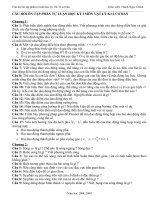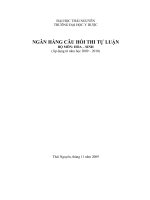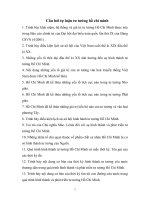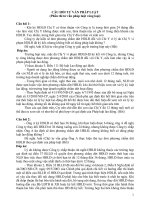C CAU HOI TU VUNG image marked image marked
Bạn đang xem bản rút gọn của tài liệu. Xem và tải ngay bản đầy đủ của tài liệu tại đây (251.54 KB, 2 trang )
C – CÂU HỎI TỪ VỰNG
Câu hỏi 9: Tìm từ đồng nghĩa, trái nghĩa (vocabulary)
Đây là dạng câu hỏi khó, yêu cầu phải đoán nghĩa của một từ khó xuất hiện trong đoạn văn dựa vào ngữ
cảnh. Tuy nhiên, trong bài vẫn để lại một vài dấu hiệu để các em có thể suy đoán.
VOCABULARY IN CONTEXT QUESTION
What is the meaning of "X" in line "Y"?
The word " X" in line "Y" could be replaced by...
Các câu hỏi
Which of the following word has the closest meaning with the word
thường gặp
"X" in line "Y"?
Which of the following has the opposite meaning with the word "X"
in line "Y"?
Câu trả lời
Dựa vào thông tin xung quanh từ được đưa ra để đoán nghĩa của từ.
- Tìm từ đó ở trong bài đọc.
Cách làm
- Đọc câu chứa từ đó cẩn thận.
- Tìm các manh mối trong ngữ cảnh để giúp hiểu ý nghĩa của từ.
- Chọn đáp án mà ngữ cảnh thể hiện.
Example The passage
In the American colonies there was little money. England did not supply the colonies with coins and did
not allow the colonies to make their own coins, except for the Massachusetts Bay Colony, which received
permission for a short period in 1652 to make several kinds of silver coins. England wanted to keep
money out of America as a means controlling trade: America was forced to trade only with England if it
did not have the money to buy products from other countries. The result during this pre- revolutionary
period was that the colonists used various goods in place of money: beaver pelts, Indian wampum, and
tobacco leaves were all commonly used substitutes for money.
The colonists also made use of any foreign coins they could
obtain. Dutch, Spanish, French, and English coins were all in use
in the American colonies.
During the Revolutionary War, funds were needed to fiance the
world, so each of the individual states and the Continental
Congress issued paper money. So much of this paper money was printed that by the end of the war,
almost no one would accept it. As a result, trade in goods and the use of foreign coins still flurished
during this period.
Trang 1
By the time the Revolutionary War had been won by the American colonists, the monetary system was in
a state of total disarray. To remedy this situation, the new Constitution of the United States, approved in
1789, allowed Congress to issue money.
Đăng ký file Word tại link sau
/>
The individual states could no longer have their own money supply. A few years later, the Coinage Act of
1792 made the dollar the offiial currency of the United States and put the country on a bimetallic
standard. In this bimetallic system, both gold and silver were legal money, and the rate of exchange of
silver to gold was fied by the government at sixteen to one.
QUESTION
The word "remedy" in paragraph 3 is closest in meaning to __________.
A. resolve
B. medicate
C. renew
D. understand
Câu hỏi: Từ "remedy" ở đoạn 3 đồng nghĩa với ________.
remedy = resolve (v): giải quyết, khắc phục
Các đáp án khác:
Medicate (v): trị bệnh
Renew (v): đổi mới
Understand (v): hiểu
GIẢI CHI TIẾT
Chúng ta có thể không biết từ "remedy" nhưng nếu các em đọc kỹ câu chứa từ này và câu xung quanh nó
thì sẽ đoán được nghĩa của từ trong ngữ cảnh. "To remedy this situation, the new Constitution of the
United States, approved in 1789, allowed Congress to issue money." (Để khắc phục tình trạng này, Hiến
pháp mới ở Mỹ được phê duyệt năm 1789 đã cho phép Quốc hội in tiền). Đáp án A là đáp án đúng.
Trang 2









